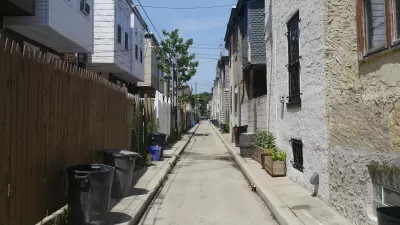As cities such as Chicago and Detroit put forth programs to turn their neglected alleyways into urban amenities, JoAnn Greco speaks with Daniel Toole, a 26-year-old, Seattle-based architect, who has accidentally become an expert on the topic
Toole's emerging expertise was the result of a travel fellowship awarded by his local American Institute of Architects branch, that allowed him to study "this arguably under-appreciated urban form" in Japan and Australia. These studies resulted in a self-published book on Tight Urbanism, an exhibition, and a blog dedicated to the study of alleyways.
Toole is optimistic that as infrastructure such as garbage collection becomes more effective, these underused assets could be appropriated for more social aims, "As waste collection becomes more effective like they've done in some places with a whole underground tube system...Maybe we'll see a proliferation of all this space becoming available. That doesn't mean it has to be turned over to pedestrians and parties, but maybe it could be used as a new kind of green infrastructure, for handling storm water, for growing things. These alleys can be turned into assets for the city. As it stands now, they present a ridiculous amount of space to be used simply for waste conveyance."
"And, of course, they are also an asset for pedestrian passage, they offer exactly the kind of thing that everyone goes to Paris and Rome for: to walk through the little streets."
But Toole needn't have traveled across the world to see examples of urban alleyways transformed into unique amenities. In fact, he needn't have left the west coast, where cities such as Pasadena and San Francisco have created wonderful places out of formerly neglected spaces.
FULL STORY: Why Alleys Deserve More Attention

Planetizen Federal Action Tracker
A weekly monitor of how Trump’s orders and actions are impacting planners and planning in America.

Maui's Vacation Rental Debate Turns Ugly
Verbal attacks, misinformation campaigns and fistfights plague a high-stakes debate to convert thousands of vacation rentals into long-term housing.

Cuomo Is the Candidate of Both NIMBYs and Developers. What Gives?
In the New York City mayoral race, odd bedfellows align to preserve the housing status quo.

San Antonio and Austin are Fusing Into one Massive Megaregion
The region spanning the two central Texas cities is growing fast, posing challenges for local infrastructure and water supplies.

Charlottesville Temporarily Has No Zoning Code
A judge ordered the Virginia city to throw out its newly revised zoning code, leaving permitting for new development in legal limbo.

In California Battle of Housing vs. Environment, Housing Just Won
A new state law significantly limits the power of CEQA, an environmental review law that served as a powerful tool for blocking new development.
Urban Design for Planners 1: Software Tools
This six-course series explores essential urban design concepts using open source software and equips planners with the tools they need to participate fully in the urban design process.
Planning for Universal Design
Learn the tools for implementing Universal Design in planning regulations.
Heyer Gruel & Associates PA
JM Goldson LLC
Custer County Colorado
City of Camden Redevelopment Agency
City of Astoria
Transportation Research & Education Center (TREC) at Portland State University
Jefferson Parish Government
Camden Redevelopment Agency
City of Claremont



























